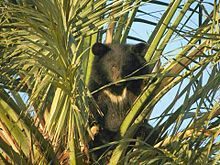Balochistan black bear
| Balochistan black bear | |
|---|---|

| |
| Scientific classification | |
| Kingdom: | Animalia |
| Phylum: | Chordata |
| Class: | Mammalia |
| Order: | Carnivora |
| Family: | Ursidae |
| Genus: | Ursus |
| Species: | |
| Subspecies: | U. t. gedrosianus
|
| Trinomial name | |
| Ursus thibetanus gedrosianus Blanford, 1877
| |

| |
| Synonyms | |
|
Selenarctos thibetanus gedrosianus | |
The Balochistan (or Baluchistan) black bear (Ursus thibetanus gedrosianus) is a subspecies of the Asian black bear occurring in the Balochistan Mountains of southern Pakistan and Iran. It has an unusually thin coat for an Asian black bear, but this is because it is found in a warmer climate than most of the other subspecies, which are found in the much colder Himalayan Mountains. It is also more frugivorous than the other subspecies, and it loves to eat figs and bananas.
Characteristics[]
The Balochistan black bear is smaller than the other subspecies and is more variable, and may range from reddish-orange to deep black. It has a darker chest patch than the other subspecies, and has a thinner head but still has the flanks branching from its head.
Habitat[]
The Balochistan black bear inhabits the higher ranges of the Balochistan province in southwest Pakistan. Its greatest stronghold is the hills south of Khuzdar. It has also been recorded in Takht-e-Sulaiman, Toba Kakar Range, Ziarat, and Kalat District.[citation needed]
It was once found in almost the entirety of Balochistan. However, it is now considered extinct in most of the area. Deforestation and loss of habitat is the greatest problem it faces.[1]
Diet[]
This species is omnivorous, as it eats fruits, insects, and small reptiles. It is also known for breaking logs in the hunt of grubs. Though they are omnivorous, their preferred diet is fruits, especially Indian olives and Ber.[2]
Major threats[]
These are captured by locals who try to raise them as pets for circuses and bear-baiting. In bear baiting, claws and canines of each bear are extracted and they are left to fight dogs. This practice was made unlawful and prohibited in 2001 but still occurs illegally to some extent.
Habitat loss is a major threat to this species because of illegal logging, the growth of human population that leads to expansion of villages, development of highways network, and installation of power stations in the wild.
Local and nomad herders let their cattle graze in the bear territory and end up in killing the native bears, blaming them for the killing of their livestock. Poaching for body parts like gall bladders for medicines is also a threat to the species.[3]
References[]
- ^ "Baluchistan Black Bears - Bears Of The World". Bearsoftheworld.net. Retrieved 1 November 2017.
- ^ "Balochistan Black Bear". Wwfpak.org. Archived from the original on 11 November 2017. Retrieved 1 November 2017.
- ^ "Balochistan Bear - Wildlife of Pakistan". Wildlife.com.pk. Archived from the original on 1 September 2018. Retrieved 1 November 2017.
- Bears
- Natural history of Balochistan, Pakistan
- Mammals of Pakistan